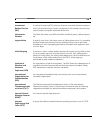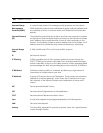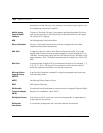
ADC Telecommunications, Inc.
596 A
PPENDIX C: GLOSSARY
of its television program material from a Master Head-end in the same
metropolitan or regional area.
DNS See Domain Name System.
DOCSIS Data Over Cable Service Interface Specification, developed by CableLabs.
Defines interface standards for cable modems transmission and supporting
equipment.
Domain Name
System (DNS)
An on-line, distributed database used to map human-readable machine
names into IP address for resolving machine names to IP addresses.
Downstream The direction of data flow from the head-end (CMTS) to the subscriber (CM).
Drop Cable Coaxial cable that connects to a residence or service location from a
directional coupler (tap) on the nearest coaxial feeder cable.
Dynamic Host
Configuration
Protocol (DHCP)
A protocol that allows dynamic assignment of IP addresses to CPEs. DHCP is
also used to assign IP addresses to CMs.
Dynamic Range The ratio between the greatest signal power that can be transmitted over a
multichannel analog transmission system without exceeding distortion or
other performance limits, and the least signal power that can be utilized
without exceeding noise, error rate or other performance limits.
Ethernet A networking standard running speeds of 1 Gbps (Gigabit Ethernet), 10
Mbps (10BaseT) or 100 Mbps (100BaseT). Ethernet typically uses twisted pair
wiring or optical fiber.
EuroDOCSIS European Data Over Cable Service Interface Specification, developed by
tComLabs and CableLabs. Defines interface standards for cable modems
transmission and supporting equipment.
Extended Subsplit A frequency division scheme that allows bidirectional traffic on a single
coaxial cable. In the U.S., reverse path signals come to the head-end from 5
to 42 MHz. Forward path signals go from the head-end from 50 or 54 MHz
to the upper frequency limit.
FDDI See Fiber Distributed Data Interface.
FEC See Forward Error Correction.


















